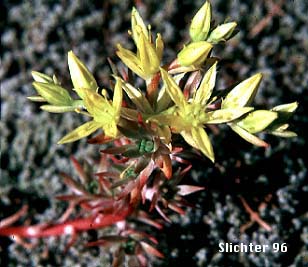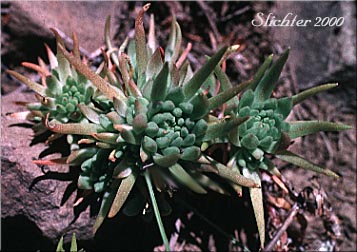

 Photo
at right of short stems and leaves of Sedum stenopetalum from Monte Carlo,
Columbia River Gorge Scenic Area, July 4, 1993.
Photo
at right of short stems and leaves of Sedum stenopetalum from Monte Carlo,
Columbia River Gorge Scenic Area, July 4, 1993.Worm-leaf stonecrop is a widespread perennial of arid or dry rocky areas with thin stems which may be erect or lax up to 20 cm in length. The herbage is generally smooth. The leaves are alternate, linear or narrowly linear-lanceolate and strongly keeled or nerved on the upper surface (See photo at right.). Many of the leaves on the stem disappear by the blooming period, giving the stems a spindly appearance. The leaves are often crooked or worm-like (hence the common name) with sharply pointed tips. Bulbil-like propagules may often be found in the axils of the persistent upper leaves.
The inflorescence is a tight cyme. The 5 petals are yellow and they range from 6-8 mm long. The sepals are lanceolate and about 2 mm long.
Sedum lanceolatum, which is rare in the gorge, is similar in appearance and habitat, but it may be identified by its leaves which are not strongly keeled on the upper surface, are rounder in cross-section, and with rounder tips.
Worm-leaf stonecrop may be found in a variety of habitats, which include rocky outcrops, rocky crevices, talus, and gravelly benches from the grasslands, sagebrush desert, ponderosa pine forest, and occasionally up into the subalpine ridges.
Worm-leaf stonecrop may be found from British Columbia south, mainly east of the Cascades, to California, and east to western Montana. It may occasionally be found on drier slopes to the west of the Cascade summit or in the Willamette Valley, and especially in the Olympic Mts..
In the Columbia River Gorge, it may be found between the elevations of 1000'-4200' from Bonneville Dam east to near The Dalles.